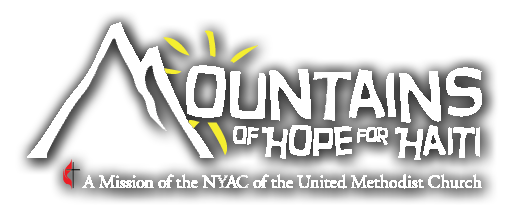Why Furcy?
The mission of Mountains of Hope began in 2004, at the request of then-Circuit Superintendent, Rev. Gesner Paul, and the resident missionaries, to build a new medical clinic in the mountain village of Furcy. Construction began in 2005 and the clinic saw its first patients in 2006.
The village of Furcy lies about 30 miles southeast, 5,000 feet above, and what seems like a world away from, the city of Port au Prince. As you make your way out of Petionville, going up Kenscoff Road, you can literally feel the temperature and humidity drop as you pass towns, market places, and farms. With improved roads, a trip that used to take over 3 hours can now be done in half that time. To get to the Furcy Mission site you must leave your vehicle at the top of a hill and walk a half mile down a steep (and often slippery) path. As you round the path to the mission site, the scene is breathtaking as more and more mountains come into view. This is, in fact, what the Taino/Arawak word “Ayiti” means: “mountainous or high land.” A phrase often used to describe Haiti is: “Beyond mountains, there are more mountains”.
And yet, the beauty often belies a struggle.
Why Furcy?
Pastors Tom and Wendy Vencuss first visited Haiti in October 2002 at the invitation of a friend. They returned six months later with a group of 8. From that, Mountains of Hope for Haiti was born. Volunteer teams from the New York Conference began working in and around Port-au-Prince, primarily at orphanages and other project sites. In 2004, at the request of the Circuit Superintendent and resident missionaries, Mountains of Hope was asked to build a new medical clinic in the village of Furcy to provide basic medical care to the many farmers and mountain people living in the surrounding hills and valleys. Working with local residents, construction began in 2004. The Clinic was completed and saw its first patients in 2006. Since then, Mountains of Hope for Haiti has expanded its mission to include support for programs in education, health care, clean water, agriculture, and community development. More recently, Furcy has been used as a base of operations for work in three additional farming communities, several as far as eight hours away by foot.
Why Furcy? Following the devastating earthquake of 2010, a former president of Haiti observed that a key to Haiti’s recovery and future is the revitalization of agriculture and rural communities. This has been true for many years. Food insecurity and hunger are chronic issues in Haiti. Although agriculture remains an important sector in the overall economy, Haiti does not produce enough crops and livestock to feed its people. The country imports 60 percent of its food, including as much as 80 percent of the rice it consumes. Periods of extreme drought and flash flooding take their toll on rural farming communities. In addition, many government and international "aid" policies have served to undermine Haiti's capacity to develop its agricultural sector and its ability to sustain itself.
While dramatic photos chronicle the difficulties of urban life, rates of poverty and extreme poverty are higher in rural communities. In times of emergency, people will often migrate from farms to the cities in search of jobs and resources. Unfortunately, the cities cannot continue to absorb these large numbers of people.
One advocate for sustainable development offered these words of advice to those working in Haiti: “Keep the big picture in mind, but focus efforts locally. Work with local authorities, community leaders, civil society. Find ways to build capacity of local organizations. Ensure that the plans made are done in full consultation with local partners.”
(Elizabeth Ferris, “Burning Issues for Haiti’s Recovery”, 2010).
Mountains of Hope for Haiti is committed to these ideals of development.




